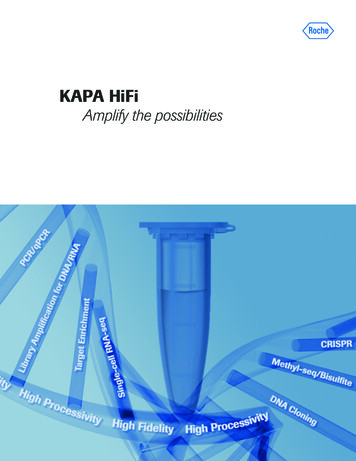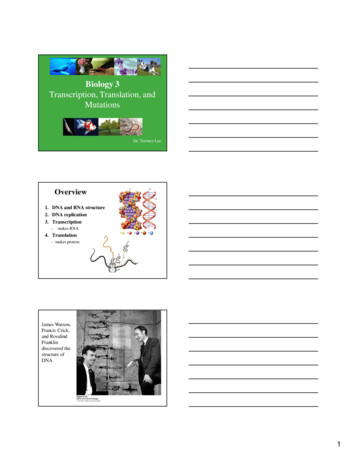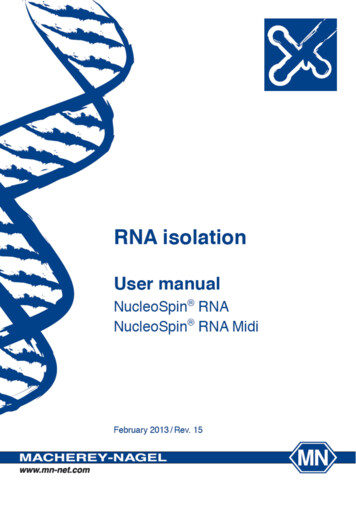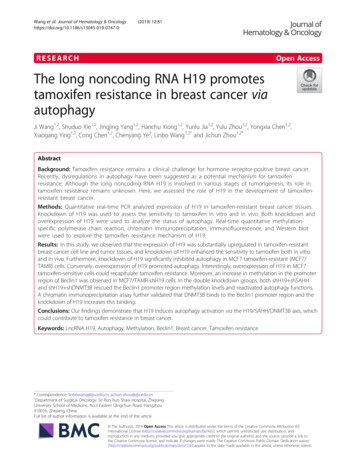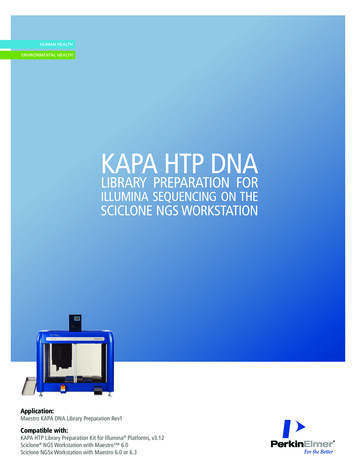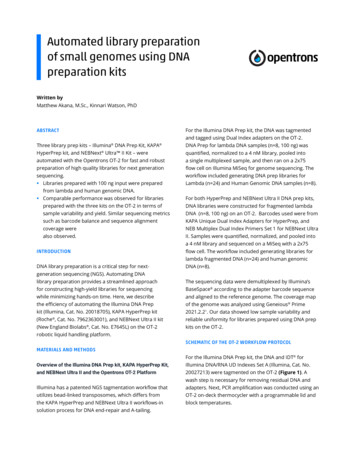
Transcription
Product SummaryKAPA RNA HyperPrep Kits for RNA-sequencingRapid, robust, and reliableExplore transcriptomics with RNA-seq and unlock discoveries with your researchStart the RNA-seq process off the right way by making high-quality libraries through thestreamlined, single-day workflow of the KAPA RNA HyperPrep Kits. Combine these flexible kitswith KAPA Dual-Indexed Adapters in an automation-friendly workflow that is compatible withmRNA capture, ribosomal depletion, and globin depletion. Construct libraries in a single day, inclusive of RNA enrichment Save steps and reduce hands-on time with streamlined protocols Achieve robust performance across different sample types and low-inputamounts, including degraded samples Rely on Roche Support throughout the entire workflow, including custom leicAcid ExtractionData on file.For Research Use Only. Not for use in diagnostic onTargetEnrichmentLibraryQuantificationReady toSequence
Choose from flexible workflow options for a broad range of applications Generate libraries from a variety of RNA sample types and input amounts, including both high-quality and degraded samples (Table 1) Rely on streamlined workflows (Figure 1) for stranded library construction when sequencing non-coding and coding transcriptsTable 1. Roche Sample Prep Solutions for RNA-seq.KAPA RNAHyperPrep KitsKAPA RNA HyperPrep Kitswith RiboErase (HMR)KAPA RNA HyperPrep Kitswith RiboErase (HMR) GlobinKAPA mRNAHyperPrep KitsRNA EnrichmentNonerRNA DepletionrRNA and Globin DepletionPoly(A) SelectionSample TypeHigh-quality total RNADegraded or FFPE total RNAPreviously enriched RNAHigh-quality total RNADegraded or FFPE total RNABlood-derived RNAHigh-quality total RNADegraded or FFPE total RNAHigh-quality total RNASpeciesEukaryotic (animal, plant, etc.)Prokaryotic (bacterial, etc.)Human, mouse, and rat*Human, mouse, and rat*Eukaryotic (animal, plant, etc.)DifferentiatingApplicationsAnalysis of specific transcripts,including those of low abundance,when paired with target enrichmentWhole transcriptome analysis,including non-coding RNA profilingWhole transcriptome analysis,including non-coding RNA profilingmRNA sequencing for codingtranscriptome analysisSharedApplicationsGene expression analysis; detection of gene fusions, isoforms, and other structural variants; SNV discovery*Custom depletion protocol support available for other organisms or transcripts. See Featured Application Note.KAPA RNA HyperPrep Kits with RiboErase (HMR)KAPA mRNA HyperPrep KitsTotal RNATotal RNA(25 ng – 1 µg) (25 ng – 1 µg)Total RNATotal RNA(50 ng – 1 µg) (50 ng – 1 µg)Hybridize RNA Hybridize RNA1st mRNA Capture1st mRNA CaptureKAPA Pure BeadsCleanupKAPAPure Beads 2.5 Cleanuphr 1.5 hr2nd mRNA Capture2nd mRNA Capture 2.5 hrDNase DigestionDNase DigestionmRNA CapturerRNA Depletion 1.5 hrDeplete rRNA Deplete rRNAwith RNase H* with RNase H*KAPA Pure BeadsCleanupKAPAPure Beads CleanupKAPA RNA HyperPrepKAPA RNA HyperPrep 4.0 hrWorkflowWorkflow 4.0 hrKAPA RNA HyperPrepKAPA RNA HyperPrep 4.0 hrWorkflowWorkflow 4.0 hrTotal library preptime:Totallibrary 6.5prephrtime: 6.5 hrTotallibrary 5.5prephrtime:Total library preptime: 5.5 hrFigure 1A. KAPA RiboErase (HMR) workflow. Sequencing of rRNAdepleted total RNA samples provides a more comprehensive representationof the whole transcriptome. rRNA is targeted and depleted enzymaticallyusing DNA probes and RNase H, resulting in improved coverage oftranscripts of interest, including precursor mRNAs and important regulatoryspecies such as non-coding RNAs.Figure 1B. mRNA Capture workflow. Sequencing of mRNA-enrichedsamples provides a focused view of the protein-coding regions in thetranscriptome. mRNA capture beads are used prior to library preparationwith the KAPA RNA HyperPrep workflow, which enriches for mRNAover non-polyadenylated species such as ribosomal, precursor, andnon-coding RNAs.*KAPA RiboErase (HMR) Globin is available for globin mRNA depletion fromblood-derived samples. Custom depletion protocol support is available forother non-HMR organisms and other transcript species.2For Research Use Only. Not for use in diagnostic procedures.
Perform single-day, single-tube library prep Reduce hands-on time and overall turnaround time with fewer enzymatic and cleanup steps (Figure 2) Produce strand-specific libraries from input RNA in approximately 4 hours Complete the entire workflow, inclusive of upfront RNA enrichment, in a standard work day Achieve high-throughput processing and consistency with automation-friendly workflowsSupplier ISupplier NFragmentation and Priming1st Strand cDNA Synthesis1st Strand cDNA Synthesis(not all reagents supplied)1st Strand cDNA SynthesisTube 1Fragmentation and PrimingTube 1Fragmentation and Priming2nd Strand Synthesis2nd Strand SynthesisAdapter Ligation(adapters sold separately)Bead Cleanup(reagents not supplied)Bead CleanupKAPA Pure Beads Cleanup (x2)A-tailingEnd Prep of cDNAAdapter LigationAdapter Ligation(adapters sold separately)Bead Cleanup(reagents not supplied)Tube 3KAPA Pure Beads Cleanup1½ hrUSER-enzyme DigestionLibrary AmplificationBead CleanupBead Cleanup(reagents not supplied)Library AmplificationLab time saved!Tube 3Library Amplification withKAPA HiFi HotStart ReadyMixTube 22nd Strand Synthesis and A-tailingTube 2Tube 2Tube 1KAPA RNA HyperPrep KitBead Cleanup 4.0 hr 6.0 hr 5.5 hrFigure 2. Streamlined, strand-specific library construction. The novel chemistry employed in KAPA RNA HyperPrep Kits allows for fewer and shorter enzymatic steps,reducing hands-on time and overall library prep time. rRNA depletion with KAPA RiboErase (HMR) or KAPA RiboErase (HMR) Globin Kits adds approximately 2.5 hours to theoverall workflow time, whereas mRNA capture adds approximately 1.5 hours. The entire workflow, from input RNA to sequencing-ready library, can easily be completed in astandard workday. All KAPA RNA HyperPrep library construction workflows are automation friendly.For Research Use Only. Not for use in diagnostic procedures.3
Sequence what matters Waste fewer reads by reducing rRNA carryover and PCR duplicates (Figures 3A and 3C) Identify more unique transcripts with equivalent sequencing (Figures 3B and 3D)rRNA 250.20.4201.6151030.723.722.9Unique transcripts detectedResidual non-informative reads (%)30126000122,90914.650KAPA RNAHyperPrep withRiboErase (HMR)10 ngKAPA RNAHyperPrep withRiboErase (HMR)Supplier I120000Supplier NKAPA RNA HyperPrepwith RiboErase (HMR)Supplier ISupplier N25 ngmRNA captureCDResidual non-informative reads Unique transcripts 00509.2130000KAPA mRNAHyperPrep10 ngKAPA mRNAHyperPrepSupplier ISupplier NKAPA mRNAHyperPrepSupplier ISupplier N50 ngFigure 3. Highly efficient library prep enables better utilization of sequencing resources. KAPA RNA HyperPrep Kits (green) enable highly efficient conversion of input RNA(enriched by either rRNA depletion or mRNA capture) to adapter-ligated library. Because fewer reads are associated with unwanted content—PCR duplicates and residual rRNA (A and C)—alarger proportion of sequencing data is associated with unique transcript identification (B and D).Libraries were generated in quadruplicate, using variable inputs of Universal Human Reference (UHR) RNA (Agilent Technologies) with either an rRNA depletion (top) or mRNA capture (bottom)prior to library construction. The lowest input for each workflow (10 ng) is lower than the validated minimum input for both KAPA RNA HyperPrep workflows. Where present, error bars representthe standard deviation.For 25 ng and 50 ng samples, paired end (2 x 100 bp) sequencing was performed using an Illumina HiSeq 2500 instrument. Reads aligning to rRNA were removed, and reads were randomlysubsampled to 14 M for comparative analyses. Transcripts were quantified using RNA-SeQC.For 10 ng samples, paired end (2 x 75 bp) sequencing was performed using an Illumina NextSeq 500 instrument. Reads were randomly subsampled to 14 M for comparative analysis prior toremoving reads aligning to rRNA and subsequent marking of duplicates. Transcripts were quantified using Kallisto (data not plotted due to analysis and sequencing depth differences).4For Research Use Only. Not for use in diagnostic procedures.
Cover your bases with higher uniformity Efficient RNA enrichment and library construction processes result in more even coverage along the entire transcript (Figure 4A) Library amplification with KAPA HiFi HotStart ReadyMix enables better coverage of difficult GC-rich regions (Figures 4B and 4C)rRNA depletion1.41.41.4mRNA captureKAPA RNA HyperPrep Kit with RiboErase (HMR), CV: h RiboEraseCV: 0.65KAPA HyperPrep(HMR)(HMR)CV: 0.65StrandedwithRibo-ZeroGoldCV: 0.69TruSeqTruSeqStrandedwithRibo-ZeroGold CV:0.69SupplierN, CV:0.69NEBNextUltra Directionalwith DepletionrRNA DepletionCV: 0.69NEBNextUltra Directionalwith rRNACV: 0.69Normalized coverage1.61.6Normalized 0606060808080100100100Normalized Coverage1.21.2Normalized Coverage1.2Normalized CoverageNormalized CoverageA1.6KAPA mRNA HyperPrep Kit, CV: 0.64SupplierCV:0.68KAPAI, mRNAHyperPrepCV: 0.64KAPAmRNAHyperPrepCV: 0.64TruSeqCV: 0.68SupplierN, StrandedCV:mRNA0.69mRNATruSeqStrandedCV: 0.68NEBNextUltraDirectionalwith mRNACaptureCV: 0.69NEBNext Ultra Directional with mRNACaptureCV: 0.690.000Normalizedpositionalongtranscript3' g ositionalongtranscript5' – 3' 5' ontranscript– sitionalong alongtranscript5' –(5'3' 5'grRNA depletion19 kbB42,684 kb42,682 kb42,686 kb42,688 kb42,690 kb42,692 kb42,694 kb42,696 kb42,698 kb42,700 kb42,702 kb42,682 kbKAPA RNAKAPA RNAKitHyperPrepHyperPrepKitwithRiboErasewith RiboErase(HMR)(HMR)Supplier ISupplier ISupplier NSupplier N[0 - 470][0 - 470][0 - 470][0 - 470][0 - 470][0 - 470]GC contentGC contentGeneGeneInput Amo untENST00000616651mRNA capture2020C63,740,000 bp63,740,00063,740,000 bpbpKAPA RNA[0 - 120]KAPA PrepRNACoverage [0 - 120]HyperKAPAmRNACoverageHyper JunctionsKitIlluminaYBX163,741,000 bp63,741,000bp63,741,000 bp3,641 bp3,639bpbp3,64163,742,000 bp63,742,00063,742,000bpbp63.743,000 bp63.743,00063,743,000bpbpCoverage [0 - 120]Coverage [0 - 120]Illumina50ngSupplierI Junctions50ngSupplierI JunctionsCoverageNEB 50ngNSupplierNEB 50ngNCoverageSupplierJunctions[0 - 120][0 - 2ENST00000493772ENST00000266077 00000473157SLC2A4RGSLC2A4RGSLC2A4RGFigure 4. Improved coverage uniformity. Libraries were generated from 25 ng (rRNA depletion) or 50 ng (mRNA capture) of high-quality UHR RNA, using the manufacturers’standard recommendations for each workflow where possible. For the 1000 most highly expressed transcripts, Roche workflows resulted in more even coverage across the entiretranscript length, as compared to the workflows from two other suppliers (A). This is evident both from normalized coverage plots and the coverage coefficient of variation (CV).KAPA RNA HyperPrep workflows, employing KAPA HiFi HotStart ReadyMix for library amplification, also better preserve difficult GC-rich regions (outlined in red), as highlighted in IGVplots of select regions of the YBX1 (B) and SLC2A4RG (C) genes.For Research Use Only. Not for use in diagnostic procedures.5
0.05B0.030.03130.0102Globin0.033.46Est. library size (million molecules)35Globin Rely on an automation-friendlyRNase H-based depletion that offers high 90reproducibility and90 minimal off-target depletion(Figure .010.4525 ng0.010.010.370.250.010.25100 ngD120Unique transcripts 05110100000113.8 113.1113.8113.1113.1109.7109.7107.9107.9113.8 113.1109.7113.8113.1113.1109.7107.925 ng100 307014.3 4.3100 1375025 ng5013251 µg1211211001001211211001001213100 ng12132012201 µg20120Figure 5. Effective library construction from blood-derived RNA. KAPA RNA HyperPrep Kits with RiboErase (HMR) Globin (green) allow for the simultaneous depletionof rRNA and globin transcripts from blood-derived RNA. Effective RNase H-based depletion and highly efficient library construction result in fewer non-informative reads (A) andPCR duplicates (not shown) as compared to the workflow from Supplier I, which employs bead-based depletion (orange). This translates to more complex libraries (B) and alarger number of sequencing reads associated with transcripts of interest (C). In addition, the Roche workflow results in much lower levels of off-target depletion (D).Libraries were prepared from different inputs of RNA extracted from human blood, as indicated on the x-axis of each graph. The 25 ng input is lower than the recommendedminimum input for the Supplier I workflow. Paired-end (2 x 125 bp) sequencing was performed on an Illumina HiSeq 2500 instrument. Data were sub-sampled to 17 M readsper sample for analysis. Each bar represents the average of three technical replicates. Transcript abundance was quantified using Kallisto. To assess off-target depletion, transcriptabundances were aggregated at the gene level and TMM-normalized prior to differential expression analysis. The expression profiles of libraries generated with or without globindepletion were compared to assess off-target depletion for each workflow.Featured Application Notes:-K APA RNA HyperPrep: A streamlined library preparation workflow that enables robust gene expression profiling using RNA-sequencing-K APA RNA HyperPrep Workflow: Recommendations and expectations for RNA-sequencing using degraded inputs-H igh-efficiency species-specific ribosomal RNA depletion with the KAPA RNA HyperPrep Kit-K APA RNA HyperPrep Kits and the Genialis NGS data analytics platform: a qualified, streamlined RNA-seq solution for gene expression analysis-K APA RiboDesigner—A custom probe design solution for rRNA depletion from single- and multi-species bacterial 38.381.81010Supplier I2581.848.448.4303050Roche1000707501 µg10558025 ngC20801 µgOff-target depleted genes (n)4 Effectivelyco-deplete cytoplasmic rRNA, mitochondrial rRNA, and globin100mRNA (Figure 5)100in an integrated, single-day workflow5GlobinResidual non-informative reads (%)5Perform convenient, effective library construction from blood samplesFor Research Use Only. Not for use in diagnostic procedures.20
Generate high-quality libraries from degraded samples Input as little as 25 ng with FFPE samples, depending on total RNA quality Achieve low duplication rates and highly efficient, reproducible rRNA removal with degraded samples (Figure 7) Identify more unique transcripts with equivalent sequencing (Figure 7B)FUFUFrozen TumorRIN: 3.0DV200: 74%3530FFPE TumorRIN: 2.2DV200: 5200500100020004000[nt]Figure 6. Quality assessment of input RNA from a paired frozen and FFPE breast tumor sample set. Blue shading highlights RNA fragments 200 nt. The regioncircled in red indicates a high-molecular-weight peak that is likely the result of crosslinking or inefficient deparrafinization and not intact material that could support library construction.Electropherograms were generated using an Agilent Bioanalyzer with an Agilent RNA 6000 Pico Kit.AResidual non-informative reads 9KAPA RNA HyperPrepwith RiboErase (HMR)Supplier I28.20Supplier NKAPA RNA HyperPrepwith RiboErase (HMR)Tumor 000118,384116,107115000116,137Mean coverage uniformity CV120000125,054Unique transcripts detectedUnique transcripts detected125000rRNA130000130000Tumor FrozenKAPA RNA HyperPrep with RiboErase (HMR)1.25Tumor FFPE Tumor FrozenKAPASupplierI RNA HyperPrepSupplier Nwith RiboErase 5113,907113,907110000110000Supplier NTumor FFPEDuplicatesBSupplier I0.50Tumor FFPETumor FrozenSupplierI RNA HyperPrepSupplier N with RiboErase (HMR)KAPATumor FFPESupplier ISupplier NFigure 7. Robust and reproducible results from degraded samples. For both the degraded frozen and FFPE breast tumor samples (Figure 6),KAPA RNA HyperPrep with RiboErase (HMR) reduces the total number of reads wasted on PCR duplicates and residual rRNA in comparison to alternativeworkflows (A). Fewer reads associated with undesired content enables increased identification of unique transcripts (B; also see Figure 8). Additionally, theKAPA workflow more evenly covers transcripts, as indicated by a lower mean coverage uniformity CV (C). See Featured Application Note.Libraries were generated in triplicate using 25 ng of total RNA. Where present, error bars represent the standard deviation. Paired end (2 x 100 bp) sequencing wasperformed using an Illumina HiSeq 2500 instrument. Reads aligning to rRNA were removed, and reads were randomly downsampled to 14 M for comparative analyses.Transcripts were quantified using RNA-SeQC.For Research Use Only. Not for use in diagnostic procedures.7
Differentially expressed transcripts by RNA-SeqApplication highlight:Tumor profilingIdentify more differentially expressed transcripts.KAPA RNA HyperPrep with RiboErase (HMR) identifies more differentially expressedtranscripts in comparison to alternative workflows. Using 100 ng of matched breast tumorand adjacent normal RNA, libraries were prepared in duplicate. Overlap analysis revealedthat the KAPA kit identified the majority of transcripts detected by other workflows, plusan additional 299, of which 174 were protein-coding. In contrast, only 2 of the transcriptsnot identified by the KAPA kit were protein-coding. Results were independently verifiedfor a subset of transcripts using an orthogonal qPCR assay (data not shown), indicatingthat differentially expressed transcripts identified only by the KAPA kit reflect measurablechanges in gene expression. See Featured Application Note.299(174 protein-coding)21 (1 protein-coding)1542362 (0 protein-coding)18 (1 protein-coding)KAPA RNA HyperPrep(HMR)KAPAwithRNARiboEraseHyperPrepwith RiboEraseSupplier(HMR) ISupplier NSupplier IOrdering information for KAPA RNA HyperPrep KitsSupplier NRoche cat. no.KAPA codeDescription*Kit size08098093702KK8540KAPA RNA HyperPrep Kit24 rxn08098107702KK8541KAPA RNA HyperPrep Kit96 rxn08098131702KK8560KAPA RNA HyperPrep Kit with RiboErase (HMR)24 rxn08098140702KK8561KAPA RNA HyperPrep Kit with RiboErase (HMR)96 rxn08308314702KK8562KAPA RNA HyperPrep Kit with RiboErase (HMR) Globin24 rxn08308241702KK8563KAPA RNA HyperPrep Kit with RiboErase (HMR) Globin96 rxn08098115702KK8580KAPA mRNA HyperPrep Kit24 rxn08098123702KK8581KAPA mRNA HyperPrep Kit96 rxn*All KAPA RNA HyperPrep Kits contain KAPA Pure Beads for reaction cleanupsOrdering information for KAPA Dual-Indexed AdaptersRoche cat. no.KAPA codeDescriptionKit size08278555702KK8722KAPA Dual-Indexed Adapters Kit (15 µM)**96 adapters x 20 µL each08278539001KK8721KAPA Adapter Dilution Buffer25 mL08861919702KK8727KAPA Unique Dual-Indexed Adapter Kit (15 μM, incl. KAPA Adapter Dilution Buffer)96 adapters x 20 μL each**Contains KAPA Adapter Dilution Buffer, as well as three additional sealing films to support multiple useFor more information on Roche RNA-sequencing solutions, visit: sequencing.roche.com/RNA-seqRoche is your trusted partner in Next-Generation SequencingConsult our dedicated Support & Applications Scientists Discuss product selection and project-specificworkflow considerations Consult and collaborate to integrate new applicationsinto your lab Develop and install Roche-demonstrated methods onautomated liquid handlers Request wet-lab and remote product training Troubleshoot product-related challengesContact the Support & Applications Team (US only)Email: support.seqls@roche.comPhone: 855-527-2246 (M-F 8:30am-5pm EST)Online Request: d by:Roche Sequencing and Life Science9115 Hague RoadIndianapolis, IN 46256sequencing.roche.comFor Research Use Only. Not for use in diagnostic procedures.HYPERPREP and KAPA are trademarks of Roche. All other product names and trademarks are the property of their respective owners. 2020 Roche Sequencing and Life Science. All rights reserved.MC-US-03447SS111003A52010/20
Figure 2. Streamlined, strand-specific library construction. The novel chemistry employed in KAPA RNA HyperPrep Kits allows for fewer and shorter enzymatic steps, reducing hands-on time and overall library prep time. rRNA depletion with KAPA RiboErase (HMR) or KAPA RiboErase (HMR) Globin Kits adds approximately 2.5 hours to the
